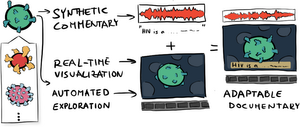Information
- Publication Type: Journal Paper with Conference Talk
- Workgroup(s)/Project(s):
- Date: November 2021
- Journal: IEEE Transactions on Visualization and Computer Graphics
- Volume: 1
- Open Access: yes
- Note: To appear (Early Access)
- Lecturer: David Kouřil
- Event: IEEE Vis 2022
- DOI: 10.1109/TVCG.2021.3130670
- Call for Papers: Call for Paper
- Conference date: 15. November 2021
- Pages: 1 – 1
- Keywords: Virtual tour, audio, biological data, storytelling, illustrative visualization
Abstract
We present a method for producing documentary-style content using real-time scientific visualization. We introduce molecumentaries, i.e., molecular documentaries featuring structural models from molecular biology, created through adaptable methods instead of the rigid traditional production pipeline. Our work is motivated by the rapid evolution of scientific visualization and it potential in science dissemination. Without some form of explanation or guidance, however, novices and lay-persons often find it difficult to gain insights from the visualization itself. We integrate such knowledge using the verbal channel and provide it along an engaging visual presentation. To realize the synthesis of a molecumentary, we provide technical solutions along two major production steps: (1) preparing a story structure and (2) turning the story into a concrete narrative. In the first step, we compile information about the model from heterogeneous sources into a story graph. We combine local knowledge with external sources to complete the story graph and enrich the final result. In the second step, we synthesize a narrative, i.e., story elements presented in sequence, using the story graph. We then traverse the story graph and generate a virtual tour, using automated camera and visualization transitions. We turn texts written by domain experts into verbal representations using text-to-speech functionality and provide them as a commentary. Using the described framework, we synthesize fly-throughs with descriptions: automatic ones that mimic a manually authored documentary or semi-automatic ones which guide the documentary narrative solely through curated textual input.Additional Files and Images
Weblinks
BibTeX
@article{kouril-2021-molecumentary,
title = "Molecumentary: Adaptable Narrated Documentaries Using
Molecular Visualization",
author = "David Kou\v{r}il and Ondrej Strnad and Peter Mindek and
Sarkis Halladjian and Tobias Isenberg and Eduard Gr\"{o}ller
and Ivan Viola",
year = "2021",
abstract = "We present a method for producing documentary-style content
using real-time scientific visualization. We introduce
molecumentaries, i.e., molecular documentaries featuring
structural models from molecular biology, created through
adaptable methods instead of the rigid traditional
production pipeline. Our work is motivated by the rapid
evolution of scientific visualization and it potential in
science dissemination. Without some form of explanation or
guidance, however, novices and lay-persons often find it
difficult to gain insights from the visualization itself. We
integrate such knowledge using the verbal channel and
provide it along an engaging visual presentation. To realize
the synthesis of a molecumentary, we provide technical
solutions along two major production steps: (1) preparing a
story structure and (2) turning the story into a concrete
narrative. In the first step, we compile information about
the model from heterogeneous sources into a story graph. We
combine local knowledge with external sources to complete
the story graph and enrich the final result. In the second
step, we synthesize a narrative, i.e., story elements
presented in sequence, using the story graph. We then
traverse the story graph and generate a virtual tour, using
automated camera and visualization transitions. We turn
texts written by domain experts into verbal representations
using text-to-speech functionality and provide them as a
commentary. Using the described framework, we synthesize
fly-throughs with descriptions: automatic ones that mimic a
manually authored documentary or semi-automatic ones which
guide the documentary narrative solely through curated
textual input.",
month = nov,
journal = "IEEE Transactions on Visualization and Computer Graphics",
volume = "1",
note = "To appear (Early Access)",
doi = "10.1109/TVCG.2021.3130670",
pages = "1--1",
keywords = "Virtual tour, audio, biological data, storytelling,
illustrative visualization",
URL = "https://www.cg.tuwien.ac.at/research/publications/2021/kouril-2021-molecumentary/",
}



